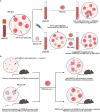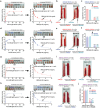Red Blood Cell Membrane-Coated Nanoparticles Enable Incompatible Blood Transfusions
- PMID: 38837643
- PMCID: PMC11304279
- DOI: 10.1002/advs.202310230
Red Blood Cell Membrane-Coated Nanoparticles Enable Incompatible Blood Transfusions
Abstract
Blood transfusions save lives and improve health every day. Despite the matching of blood types being stricter than it ever has been, emergency transfusions among incompatible blood types are still inevitable in the clinic when there is a lack of acceptable blood types for recipients. Here to overcome this, a counter measure nanoplatform consisting of a polymeric core coated by a red blood cell (RBC) membrane is developed. With A-type or B-type RBC membrane camouflaging, the nanoplatform is capable of specifically capturing anti-A or anti-B IgM antibodies within B-type or A-type whole blood, thereby decreasing the corresponding IgM antibody levels and then allowing the incompatible blood transfusions. In addition to IgM, the anti-RBC IgG antibody in a passive immunization murine model can likewise be neutralized by this nanoplatform, leading to prolonged circulation time of incompatible donor RBCs. Noteworthily, nanoplatform made by expired RBCs (>42 days stored hypothermically) and then subjected to lyophilization does not impair their effect on antibody neutralization. Most importantly, antibody-captured RBC-NP do not exacerbate the risk of inflammation, complement activation, and coagulopathy in an acute hemorrhagic shock murine model. Overall, this biomimetic nanoplatform can safely neutralize the antibody to enable incompatible blood transfusion.
Keywords: antibody; biomimetic nanoparticle; cell membrane; incompatible blood transfusion; neutralization.
© 2024 The Author(s). Advanced Science published by Wiley‐VCH GmbH.
Conflict of interest statement
The authors declare no conflict of interest.
Figures







Similar articles
-
A novel role for C3 in antibody-induced red blood cell clearance and antigen modulation.Blood. 2013 Sep 5;122(10):1793-801. doi: 10.1182/blood-2013-06-508952. Epub 2013 Jul 22. Blood. 2013. PMID: 23878139 Free PMC article.
-
Biphasic clearance of incompatible red blood cells through a novel mechanism requiring neither complement nor Fcγ receptors in a murine model.Transfusion. 2012 Dec;52(12):2631-45. doi: 10.1111/j.1537-2995.2012.03647.x. Epub 2012 Apr 15. Transfusion. 2012. PMID: 22502635
-
Resistance of a subset of red blood cells to clearance by antibodies in a mouse model of incompatible transfusion.Transfusion. 2013 Jun;53(6):1319-27. doi: 10.1111/j.1537-2995.2012.03910.x. Epub 2012 Oct 3. Transfusion. 2013. PMID: 23033973
-
Examining the Role of Complement in Predicting, Preventing, and Treating Hemolytic Transfusion Reactions.Transfus Med Rev. 2019 Oct;33(4):217-224. doi: 10.1016/j.tmrv.2019.09.006. Epub 2019 Oct 18. Transfus Med Rev. 2019. PMID: 31679762 Free PMC article. Review.
-
The monocyte monolayer assay, an in vitro method for prediction of in vivo survival of transfused incompatible red blood cells: a review.Immunohematology. 2023 Jul 5;39(2):61-69. doi: 10.21307/immunohematology-2023-010. eCollection 2023 Jun 1. Immunohematology. 2023. PMID: 37405851 Review.
Cited by
-
Lung Epithelial Cell Membrane-Camouflaged ROS-Activatable Berberine Nanoparticles for Targeted Treatment in Acute Lung Injury.Int J Nanomedicine. 2025 May 15;20:6163-6183. doi: 10.2147/IJN.S514611. eCollection 2025. Int J Nanomedicine. 2025. PMID: 40391301 Free PMC article.
-
Synthetic circRNA therapeutics: innovations, strategies, and future horizons.MedComm (2020). 2024 Nov 9;5(11):e720. doi: 10.1002/mco2.720. eCollection 2024 Nov. MedComm (2020). 2024. PMID: 39525953 Free PMC article. Review.
-
Advances in constructing biocompatible nanocarriers.Drug Deliv Transl Res. 2025 Jun 18. doi: 10.1007/s13346-025-01893-x. Online ahead of print. Drug Deliv Transl Res. 2025. PMID: 40531369 Review.
-
Photocatalytic methane oxidation over a TiO2/SiNWs p-n junction catalyst at room temperature.Beilstein J Nanotechnol. 2024 Sep 2;15:1132-1141. doi: 10.3762/bjnano.15.92. eCollection 2024. Beilstein J Nanotechnol. 2024. PMID: 39286451 Free PMC article.
-
Nerve growth factor-loaded biomimetic prussian blue nanocomplexes for reversing osteoporosis via promoting osteoblast precursor cell proliferation and differentiation.Mater Today Bio. 2025 May 22;32:101898. doi: 10.1016/j.mtbio.2025.101898. eCollection 2025 Jun. Mater Today Bio. 2025. PMID: 40520557 Free PMC article.
References
-
- Fahimnia B., Jabbarzadeh A., Ghavamifar A., Bell M., Int. J. Prod. Econ. 2017, 183, 700.
MeSH terms
Grants and funding
- LR22H150001/Zhejiang Natural Science Foundation
- WKJ-ZJ-2339/Key Projects Jointly Constructed by Zhejiang Province and the Ministry
- 2021ZY0002/Major Innovation Project of Wenzhou Science and Technology Bureau
- 2023J037/Key Project of Ningbo Science and Technology Bureau
- LTGY23H040006/Project of Zhejiang Natural Science Foundation
LinkOut - more resources
Full Text Sources
Miscellaneous
